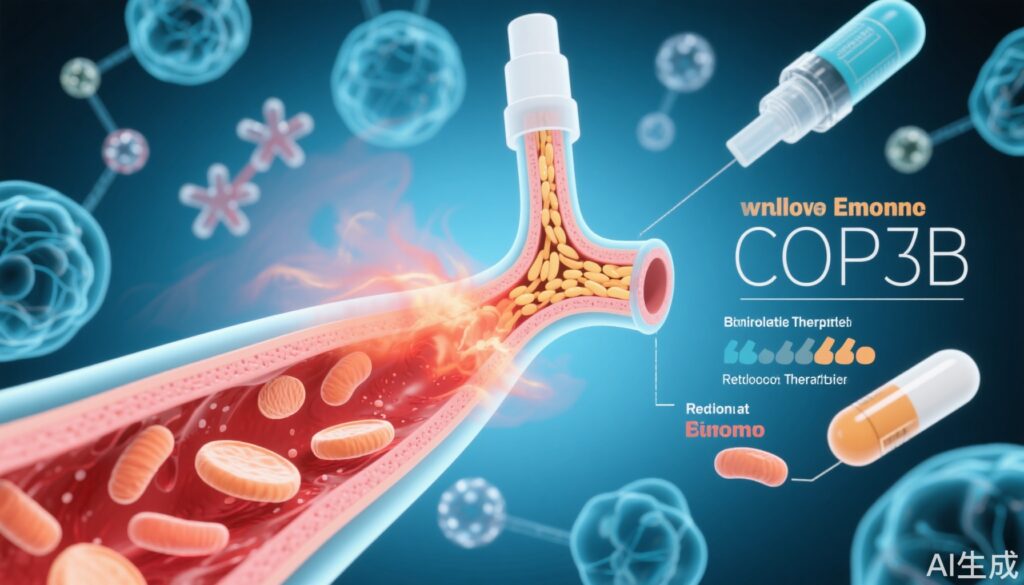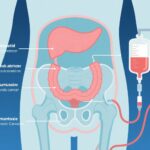Highlights
- Dupilumab treatment in COPD patients with type 2 inflammation resulted in significant reductions in key inflammatory biomarkers (total IgE, FeNO, eotaxin-3, PARC) versus placebo.
- Greater reductions in exacerbation risk were observed in patients with higher baseline blood eosinophil counts and FeNO levels.
- These findings support biomarker-guided selection of biologic therapy in COPD, particularly for patients with evidence of type 2 inflammation.
Clinical Background and Disease Burden
Chronic obstructive pulmonary disease (COPD) remains a leading cause of morbidity and mortality worldwide, characterized by persistent respiratory symptoms, airflow limitation, and a risk of acute exacerbations. While conventional therapies (bronchodilators, inhaled corticosteroids) improve symptoms for many, a significant subset of patients continues to experience frequent exacerbations, especially those exhibiting an inflammatory endotype marked by elevated blood eosinophils. Type 2 (T2) inflammation, characterized by cytokines such as IL-4, IL-5, and IL-13, is increasingly recognized in a subset of COPD patients, overlapping with features of asthma. There is a pressing unmet need for targeted therapies in COPD patients with T2 inflammation who remain inadequately controlled on standard regimens.
Research Methodology
The BOREAS study was a phase 3, multicenter, double-blind, randomized controlled trial conducted across 275 sites in 24 countries. The trial enrolled 939 adults with moderate-to-severe COPD and evidence of type 2 inflammation, defined by a screening blood eosinophil count of ≥300 cells per μL. Participants were randomized 1:1 to receive either dupilumab (300 mg subcutaneously every two weeks for 52 weeks) or matching placebo. Randomization was stratified by country and baseline inhaled corticosteroid dose. The post-hoc analysis focused on longitudinal changes in blood eosinophil counts, fractional exhaled nitric oxide (FeNO), serum eotaxin-3, total plasma immunoglobulin E (IgE), and serum pulmonary and activation-regulated chemokine (PARC) concentrations. The primary endpoint was annualized rate of moderate-to-severe exacerbations, with secondary endpoints including biomarker changes and lung function metrics.
Key Findings
At 52 weeks, the dupilumab group demonstrated significantly greater reductions across multiple biomarkers of type 2 inflammation compared to placebo:
- Total IgE: median change -22.5% (IQR -30.4 to -16.5) vs -0.9% (-6.5 to 4.8)
- FeNO: -28.6% (-57.1 to 0) vs -6.9% (-35.7 to 25.0)
- Eotaxin-3: -8.8% (-15.6 to -2.9) vs -0.4% (-5.6 to 5.0)
- PARC: -14.4% (-29.2 to 2.1) vs -0.8% (-13.9 to 17.2)
Reductions in these biomarkers were generally consistent regardless of further stratification by blood eosinophil count. Importantly, patients with higher baseline blood eosinophil counts and FeNO experienced a greater magnitude of exacerbation risk reduction. The statistical significance of these predictive relationships was confirmed (p=0.0056 for eosinophils; p=0.043 for FeNO). The overall safety profile of dupilumab was consistent with previous studies, with no unexpected adverse events reported.
Mechanistic Insights and Biological Plausibility
Dupilumab is a monoclonal antibody that targets the IL-4 receptor alpha subunit, blocking signaling of both IL-4 and IL-13—central cytokines in type 2 inflammation. The observed reductions in IgE, FeNO, eotaxin-3, and PARC are biologically consistent with reduced type 2 cytokine activity. The correlation between higher baseline eosinophils/FeNO and greater clinical benefit reinforces the role of T2 inflammation in COPD pathobiology and patient heterogeneity. This mechanistic alignment supports the rationale for using T2 biomarkers to guide biologic therapy selection in COPD, echoing established practices in severe asthma management.
Expert Commentary
Current guidelines for COPD recommend consideration of blood eosinophil counts to guide inhaled corticosteroid use, but the role of biologics has been less clear. The BOREAS findings highlight the potential for targeted biologic therapy in a defined subset of COPD patients. As Professor Meilan Han, an expert in airway diseases, has noted, “The era of precision medicine in COPD is just beginning, and identifying the right patients for the right therapy is crucial.” Biomarker-driven approaches, such as those validated in BOREAS, could shift the treatment paradigm for patients with persistent exacerbations and T2 inflammation.
Controversies or Limitations
While BOREAS provides compelling evidence for dupilumab in T2-high COPD, several limitations warrant consideration:
- The study population was pre-selected for elevated blood eosinophils (≥300 cells/μL), limiting generalizability to all COPD patients.
- Although reductions in biomarkers were observed, the direct link between biomarker change and individual clinical outcomes requires further validation.
- The trial duration was one year; long-term safety, efficacy, and cost-effectiveness of dupilumab in COPD remain to be established.
- Potential confounding by smoking status was not fully explored, though stratification was performed.
Conclusion
The BOREAS trial demonstrates that dupilumab significantly reduces both type 2 inflammatory biomarkers and exacerbation risk in COPD patients with elevated eosinophils and/or FeNO. These results support a move towards biomarker-driven therapy in COPD, similar to current practice in severe asthma. Further research is needed to refine patient selection, assess long-term outcomes, and evaluate broader health-economic implications. Nevertheless, these findings represent a significant step forward in personalized care for COPD patients with type 2 inflammation.
References
1. Christenson SA, Hanania NA, Bhatt SP, et al. Type 2 inflammation biomarkers and their association with response to dupilumab in COPD (BOREAS): an analysis of a randomised, placebo-controlled, phase 3 trial. Lancet Respir Med. 2025 Aug;13(8):687-697. doi: 10.1016/S2213-2600(25)00044-X. Epub 2025 Jul 9. PMID: 40651490.
2. Global Initiative for Chronic Obstructive Lung Disease (GOLD) 2024 Report. https://goldcopd.org/
3. Agusti A, Fabbri LM. Inhaled corticosteroids in COPD: when, how much and for whom? Eur Respir J. 2018;52(6):1801539.
4. Rabe KF, Watz H. Chronic obstructive pulmonary disease. Lancet. 2017 May 13;389(10082):1931-1940.


